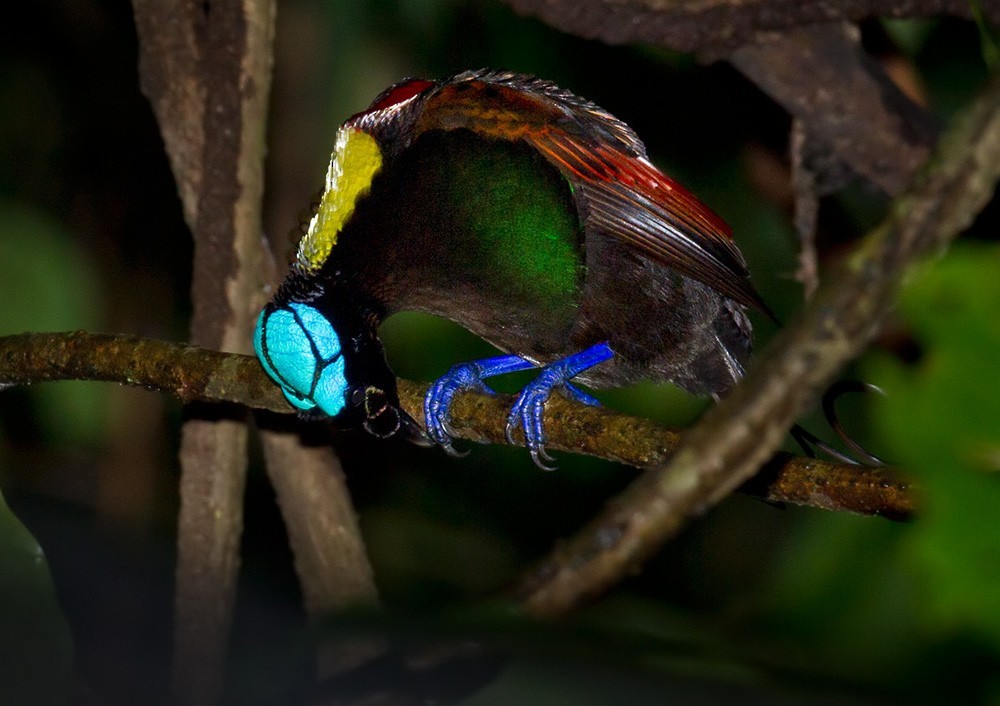Wilson's Bird-of-paradise
A species of Diphyllodes Scientific name : Diphyllodes respublica Genus : Diphyllodes
Wilson's Bird-of-paradise, A species of Diphyllodes
Botanical name: Diphyllodes respublica
Genus: Diphyllodes
Content
Description General Info
 Photo By Lars Petersson
Photo By Lars Petersson Description
Wilson's bird-of-paradise is rather small. Males can reach a length of 16 centimetres (6.3 in) (21 cm including central rectrices) and a weight of 53–67 g., while females can reach a length of 16 cm,but a weight of 52–60 g. The male is a red and black bird-of-paradise, with a yellow mantle on its neck, light green mouth, rich blue feet and two curved violet tail feathers. The head is naked blue, with a black double cross pattern on it. The female is a brownish bird with bare blue crown. In the field, the blue bare skin on the crown of the bird's head is so vivid that it is clearly visible by night; the deep scarlet back and velvet green breast are lush, the curlicue tail gleaming bright silver. 
Size
16 cm
Nest Placement
Tree
Feeding Habits
Wilson's Bird-of-paradise primarily feeds on fruits, insects, and invertebrates, foraging in the forest canopy. It exhibits specialized behaviors to access a varied diet, showcasing unique adaptations for its ecological niche.
Habitat
Wilson's Bird-of-paradise is predominantly found in the hilly rainforests, thriving particularly at elevations starting around 300 meters. These habitats usually range from hilly terrains up to the summits of larger islands, which may extend to altitudes of approximately 1000–1200 meters. The species is less frequently seen in lowland and middle montane rainforests, indicating a preference for the specific microclimates and ecological conditions that hill forests provide.
Dite type
Frugivorous
General Info
Feeding Habits
Bird food type

Fruit
Behavior
Male Wilson’s Birds of Paradise are the most colorful of all the species within the family, possessing a veritable rainbow of color. This remarkable example of hue and iridescence possesses all of the primary colors (and more) in different ways. The baby blue hue of its head is skin, not feathers, and is the result of structural color absent in any other member of birds of paradise. Yellow on the nape of its neck, followed by the crimson on its back are consistent, pigmented colors, present year-round. Its quirky, “handlebar-mustache-shaped” tail feathers are brilliantly iridescent, reflecting light to produce intense color to the eye of the beholder. The sexual dimorphism of the species leaves the female very drab in comparison. Sexual dimorphism, or the difference in physical appearance between the sexes, is the result of female selection, in which females select males based upon indirect genetic benefits which increase offspring fitness. Because this species is polygynous, where one male mates with multiple females, the female is left on her own to raise young, forcing her to assess these indirect genetic benefits through courtship rituals, details of which are in the following section. Dance While these birds are difficult to locate in the wild and have not been studied in-depth, footage of the few mating rituals that have been witnessed for this species tells all. This species territorially defends a “court” in which it performs its vocalizations and physical maneuvers. Males will continually work to keep this area free of debris, making sure that nothing on the ground will distract from their displays. Males will perch on a vertical branch in the middle of their court, flexing their brilliant green fluorescent collar and calling out to females to attract them to their site. Females who are interested will perch above the male on the branch and watch as he weaves back and forth, calling to her and flexing the fluorescent collar. As was recently discovered when researchers filmed the dance from the female's perspective, as the male displays, he is basically a brilliant green disc, and the inside of his mouth is fluorescent, making him an astonishing beacon of brilliant color. This phenomenal display of color demonstrates the power of female sexual selection over male appearance and behavior in the animal kingdom. 
Distribution Area
An Indonesian endemic, the Wilson's bird-of-paradise is distributed to the hill and lowland rainforests of Waigeo and Batanta Islands off West Papua. Due to ongoing habitat loss, limited range and exploitation, the Wilson's bird-of-paradise is evaluated as Near Threatened on the IUCN Red List of Threatened Species. It is listed on Appendix II of the Convention on International Trade in Endangered Species of Wild Fauna and Flora (CITES). 

 Photo By Lars Petersson
Photo By Lars Petersson Scientific Classification
Phylum
Chordates Class
Birds Order
Perching birds Family
Birds-of-paradise Genus
Diphyllodes Species
Wilson's Bird-of-paradise